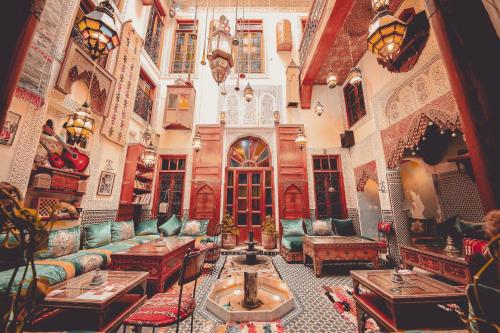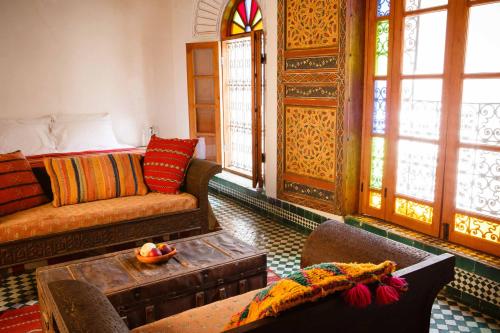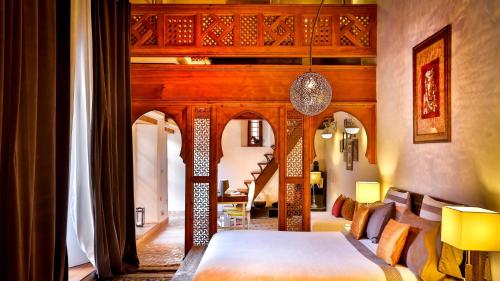The best things to do in Fez Medina
The incredible city of Fez, Morocco, has so much to do and the best are in the historic centre. These are my tips on what to do in the Medina of Fez.
**Jump to map of the best things to do in Fez Medina**
The squawk of the chicken and the frantic flap of its wings in the seconds before it has its throat cut is unsettling, to say the least. Then there’s just silence as red seeps into the white feathers on its neck.
The other birds in the shop seem not to have noticed the death of their friend, or perhaps they just don’t understand. There’s no fuss from them even though their lives can surely be counted only in minutes.
It’s one of the first things I see as I walk down the main street of the old medina here in the Moroccan city of Fez. Quite an introduction!
The Medina of Fez, Morocco
Well, I say ‘main street’ but just five minutes later I find another ‘main street’. By the end of the day, I’ve found half a dozen more. All of them have on display the same brutal reality of life – the only shop with sugarcoating is selling local candies.
In one small square, men sit on stools outside banging copper into place as they make pots in front of the crowds rushing past. I peek through a wooden door that I’m passing and see workers with large looms creating future wares.
Follow the right little alleyways and you’ll come across the infamous tanneries where the animal skins are treated in the open air and plain view.
It feels rough and raw – but I guess that’s because I’m comparing the Fez medina to the Western cities where I grew up.
Outside the earthen walls of this old part of town, things are a bit more relatable. But when you’re inside them – in the crooked alleyways with just glimpses of sunlight, smoke billowing up from stoves, the glow of lamps reaching out from stalls – you lose perspective of time.
Not just the amount of time you have been wandering through the enormous labyrinth – and it’s certainly easy to lose track of that. But also the medina’s position in the timeline of Morocco’s culture.
It may be the 21st century as I wander through the souks and residential areas but, in many ways, it could be any century from the past millennium.
History of Fez Medina
The medina of Fez was founded in the 9th century at around the same time that Islam arrived in Morocco and the imperial rule that would create the country began. It grew in the 12th and 13th centuries to about the size that it is today.
Many of the buildings that loom over the small streets are from this period, renovated to keep up with modern usages but retaining the original character of this period.
Many of the madrasas, the fondouks, the mosques and the palaces – they were built during the great expansion of these early centuries. You can see the detailed design on their walls and with their structures.
There’s a good reason that the Medina of Fez has been named as a World Heritage Site!
Things to do in Fez Medina
To help you with a visit to the city, I’ve put together this list of things to do in Fez Medina. You can use the map to see where they’re located (but be warned that the GPS can be quite unreliable in the maze of the old town).
Bab Bou Jeloud (Blue Gate)
One of the first things you might see, depending on how you come in, is the Blue Gate. Officially it’s called Bab Bou Jeloud and it’s a popular meeting spot.
This western entrance originally was quite a simple gate that was built in the 12th century – and you can see that on the left side.
This new gate was built in 1913 by the French when they controlled the city. Its design was inspired by Moorish architecture, which makes it look much older than it actually is.
Al Attarine Madrasa
This madrasa (Islamic school) is one of the most beautiful buildings in the Medina of Fez. It was built in the early 1300s and is next to the spice and perfume market.
The highlight in the central courtyard that opens onto the prayer hall. The colourful mosaic tiles and carved stucco create a detailed work of art on the walls.
Around the courtyard are the student rooms that are very modest by comparison but give you an insight into the life of the school.
Bou Inania Madrasa
The other madrasa in Fez Medina that is worth visiting is Bou Inania Madrasa. Don’t think just because you’ve seen one, you don’t need to see the other. They are each special in their own ways.
Bou Inania Madrasa was built in the middle of the 1300s and has an enormous brass entrance door. Inside, you’ll find the colourful geometric tilework and carved plaster plus lattice screens made from cedar.
Unlike most madrasas, this one has its own mosque and so you’ll also notice the tall minaret rising up from the top.
Chouara Tannery
The tanneries are one of the things that tourists seem to want to see – but if they don’t appeal to you, you’re not really missing out. So don’t worry.
The largest of the tanneries is Chouara Tannery and there you’ll find men working away, putting the animal skins into white liquids to soften them and then dyes to give them colour, before they are dried in the sun and become leather.
There are a lot of touts who will offer to take you the the tannery… for a price. The shops around the area may let you go in to have a look… but will expect either a tip or that you buy something. And you may even be able to pay someone at the main entrance to go in and take some photos.
However you go, expect to be hassled for money and have to pay at least someone something. There really isn’t a free view here.
University of Al Quaraouiyine
According to both UNESCO and Guinness World Records, Al Quaraouiyine is the oldest university in the world, having been founded in 859.
It is not as visually-spectacular as the madrasas I have mentioned but it still has a beautiful design with arched doorways, a tiled floor, and colourful artworks.
The university is attached to a mosque and so entry is only permitted for Muslims. There has recently been an extensive renovation of the buildings and I have been told that, if you are non-Muslim, you may be able to go into the library (the entrance is on the other side to the mosque) so give that ago. Otherwise you can still look through the main door.
Zaouia de Moulay Idriss
It’s also worth mentioning the mausoleum of Zaouia de Moulay Idriss, which is dedicated to the founder of Fez. Idris II died in 828 and nobody knows for sure where his body is. However, it’s believed that he was buried on this spot.
The shrine that’s here today was built in 1720, although there had been other versions on the site for several centuries. The minaret is the tallest in Fez Medina.
Only Muslims are allowed to enter. Inside is a central courtyard with a white marble fountain, with the mausoleum chamber at the southern end. Non-Muslims should be able to get a bit of a view through the main entrance.
Dar Batha
The Dar Batha – or Batha Museum – was a summer palace built in the 19th century that was turned into a museum in 1915.
It has an excellent collection of traditional arts and crafts from Morocco and will be of interest to anyone who’s been taking note of the beautiful designs here in Fez.
Dar Batha is particularly known for its collection woodcarving, although there are also examples of the colourful tile mosaics, embroidery, and carpets.
Funduq al-Najjariyyin
The Funduq al-Najjariyyin (also written Fondouk el-Nejjarine) doesn’t get a lot of attention but I think it’s really interesting because it has two reasons to visit.
The first is the building itself. It was built in the 1700s as a roadside inn, where travellers could rest and stock up on supplies – plus share information with people heading the same way.
It has a large entranceway that leads through to a central courtyard that has three levels with rooms coming off the balconies.
The second reason why it’s worth visiting is because it’s now been turned into a museum, dedicated to wooden arts and crafts. There are some lovely pieces here so, even if you’re coming for the architecture, there’s a bit of a bonus.
Souks
And, finally, I’m going to mention the souks in the Medina of Fez. There’s probably no need, because you’re going to find them even if you don’t try, but these old markets are one of the most interesting parts of the city.
You’ll realise that different souks throughout the medina specialise in different products. I don’t think any one of them is better than the other, because it all depends on what you’re looking for. And, if you’re just curious, go to as many as possible to see the range.
Aim to have a look at the oldest one at Souk el Henna, and then choose from any of the ones surrounding it, including Souk Al-Attarine, Souk Serrajine, Souk Tillisse, Souk Haik, and Souk Jeld.
If you’re interested in learning more about these key spots in the Fez Medina, you’ll get a lot more out of a local guide. Have a look at some of these options:
Exploring Fez Medina
Fez was the capital of Morocco until 1912 and, although political power may have moved to Rabat, this still feels like the cultural and spiritual centre of the country. It has an energy that is inescapable that comes as much from the buildings as it does the people.
I wonder how different the behaviour is here these days compared to hundreds of years ago. I suspect not too much. It’s one of the reasons I find it so hard to place the medina of Fez in a particular place in time.
The donkeys that walk up the steps carrying goods to shops have probably always done that; the men sitting and smoking on wooden stools in front of their carpet shops would never have look out of place; the markets full of fruits and vegetables on the outer edge of the city wall has probably always been just as busy.
And then there’s that poor chicken slaughtered right in front of me. That’s probably also just how things have been done here for centuries. It makes the sight a little less confronting, I have to say.
I like that Fez doesn’t feel modern and it doesn’t feel sanitised for tourists or for contemporary expectations. As I said, it’s raw and it’s rough and that’s what makes this medina such a magical place and a real highlight of urban Morocco.
THE BEST ACCOMMODATION IN FEZ
The medina of Fez has a huge range of riads that should cater to whatever style of accommodation you’re looking for.
BACKPACKER

For a backpacker option right in the heart of the medina, I would recommend Riad Verus.
BUDGET

A lovely affordable option with a friendly atmosphere is Riad Dar Fes.
BOUTIQUE

For a fantastic boutique hotel, I would suggest Riad Idrissy in a great spot in the medina.
LUXURY

And if you want some luxury, the Karawan Riad is a really special place.
Raw is the word. I love how the colors fuse with the raw creating a canvas like no other. Such beautiful pictures.
You’re so right – all the different colours make it really interesting. And I like the gritty element to it all as well.
Fez seems like such a vibrant, colorful maze to get lost in. I especially like the pictures of the craftsmen at work 🙂
The craftsmen are great. That’s one of the best things about Fez – so much action going on everywhere!
It looks full of life and color… I love the narrow streets. Great read. Thanks.
You say you love the narrow streets… but clearly you haven’t tried to push through the crowds of people during a busy day!! 🙂
I know just what you mean! After a few days of staying in the middle of the medina of Fez, when we finally made it out to the new part of town – to catch a bus – it was like… going into the future. Its like we were convinced we had actually gone back in time.
Exactly! And that’s what I love so much about the old parts of the Moroccan cities. You really feel like they haven’t changed too much. I feel bad I didn’t see a bit more of the modern parts of the the cities but I imagine they’re not too exciting – nice to live but less atmosphere.
Love Fez and these pictures capture the beauty of Fez. Staying in a Riad is a must
so nice collection of raw materials 🙂
Hi Michael,
I wanted to take a moment to thank you for this beautifully written and insightful article about the Medina of Fez. As a tour operator and travel expert in Morocco with nearly nine years of experience, I truly appreciate how you’ve captured the essence of this unique and historic place.
Your vivid descriptions of the sights and sounds, like the bustling souks and the mesmerizing craftsmanship of the madrasas, really bring the medina to life. I particularly enjoyed how you highlighted the raw and authentic nature of Fez, especially in parts like the tanneries and the local markets. These details truly showcase the timelessness of this incredible city.
It’s wonderful to see Fez portrayed in such an authentic light, reflecting both its beauty and its realness. Your article is an excellent resource for anyone looking to explore the cultural heart of Morocco.
Thank you again for sharing your experiences and helping others discover the magic of Fez!
Best regards,
Mustapha
Tour Operator and Travel Expert in Morocco
Thanks for the info, it is appreciated